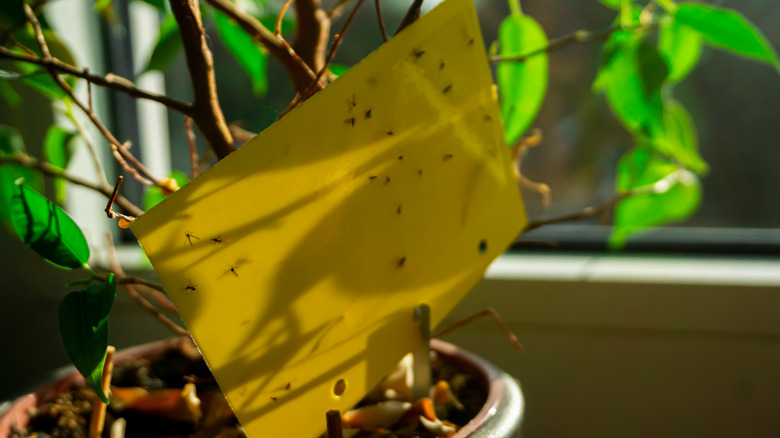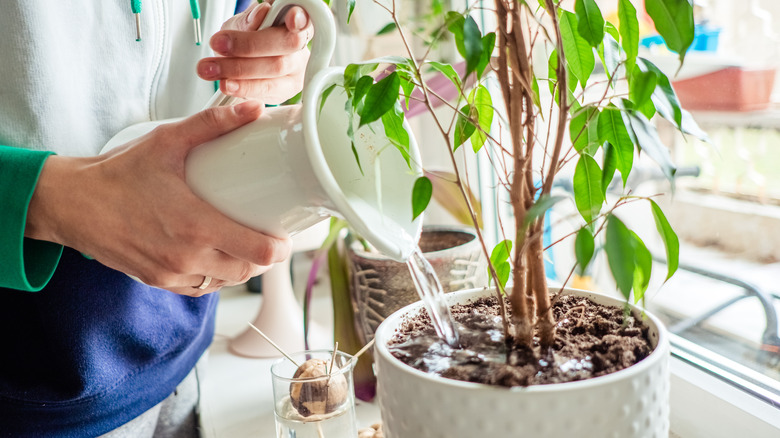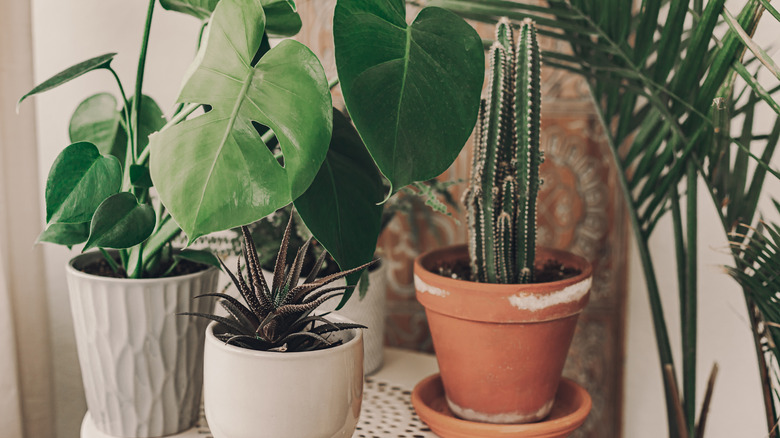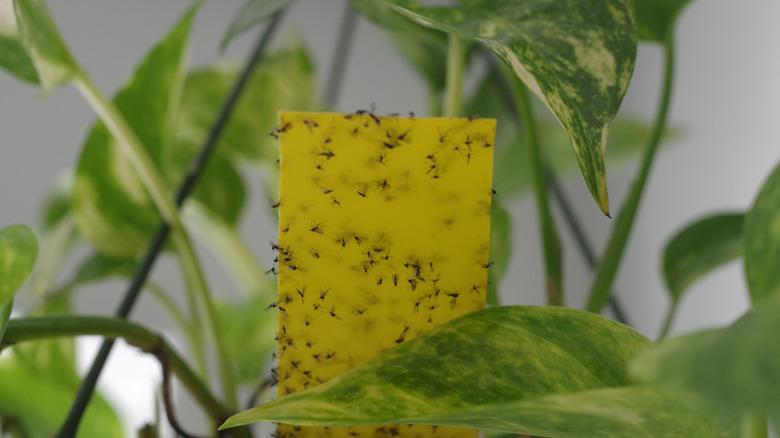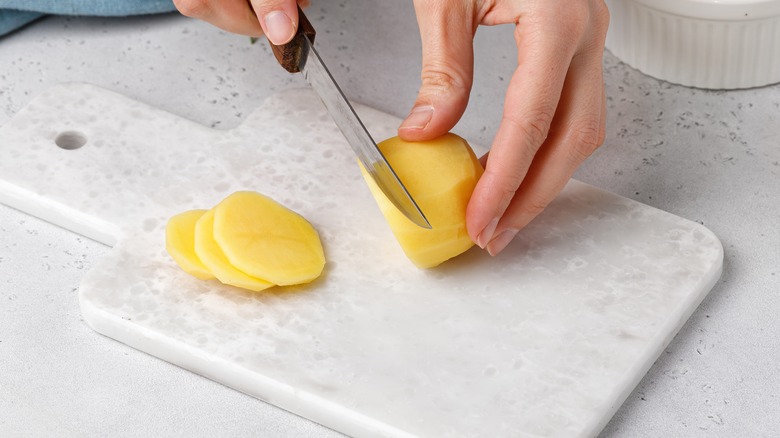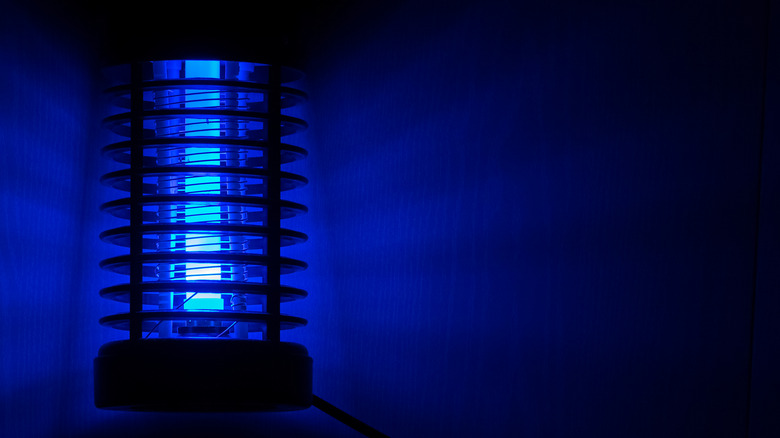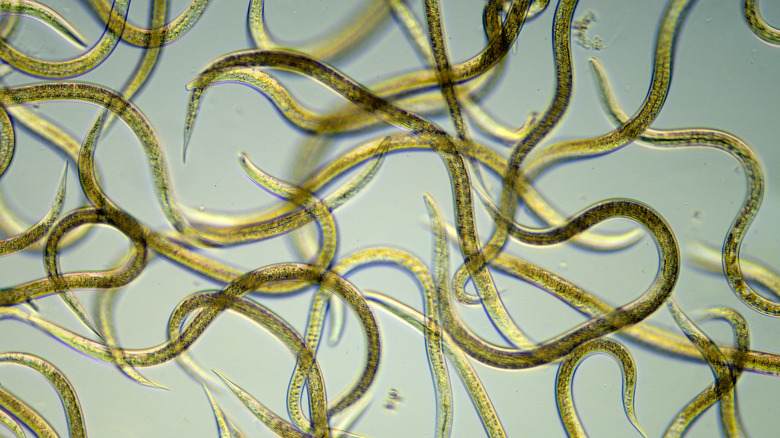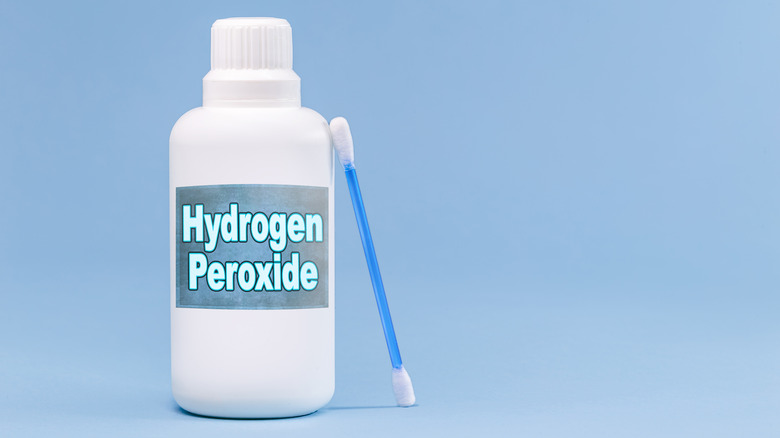What Are Fungus Gnats And How To Get Rid Of Them
Caring for houseplants is a great hobby and passion for many people. Nurturing a small plant into a full, mature, and even blossoming one is an incredibly satisfying and rewarding feat. On the flip side, noticing your plant is sick or infected can be heartbreaking. Luckily, most common houseplant ailments are very easy to identify and cure.
If you've noticed small little gnats or flies around your houseplant, you may assume the worst in terms of its health. Don't fret, though. These are just fungus gnats from the Sciaridae family, and they are generally harmless, according to Wisconsin Horticulture. Despite their name, the presence of fungus gnats does not mean that your plant has a fungal infection. What it does mean, though, is that your plant is either overwatered or retaining too much water. The flies are typically not harmful to the plant itself, but having a host of gnats flying around your home can be incredibly bothersome. In some extreme cases, they may also lay eggs, which can be both detrimental to your plant and your home. Thankfully, there are a few household remedies to prevent and get rid of these small pests.
1. Preventative measures
The easiest way to avoid fungus gnats in your plants is to prevent them from making a home in the first place. There are a few reasons that fungus gnats may choose a particular plant, including soil moisture levels, debris, and light conditions, explains Missouri Botanical Garden. Fungus gnats, and other pests for that matter, love wet and moist conditions. If you're overwatering your houseplants, one of the first signs before dying leaves and root rot may be fungus gnats. Luckily, this problem is much easier to treat than later symptoms — simply cut back on watering. Alternatively, if your plant is extra thirsty, repot it using moisture-retaining, well-draining soil.
Fungus gnats also like debris, such as dead leaves, old mulch, and fertilizer. Fungus gnats lay their eggs under the soil and then feed on the debris as the larvae hatch, so clearing out all dead leaves and old matter will help them from repopulating. In addition, fungus gnats like light sources, including lamps and windows. If your plant isn't overwatered and it's clean from debris, you can try moving it to a shadier position.
2. Soil additives
Another way to naturally prevent and avoid fungus gnats is to help prevent moisture retention in alternate ways. Some plants need frequent watering, and simply cutting back watering or repotting in a different soil may not work for every type of houseplant. For thirstier plants, Wisconsin Horticulture recommends trying to bottom water them. Bottom watering involves putting your entire plant pot in either a shallow bowl or dish of water and letting your plant drink from the bottom up. This will keep the roots moist but the top dry. Be warned, though, that some plants don't like sitting in water and will not appreciate this method.
You can also add some additives to the top of your soil to make it more inhospitable to fungus gnats and their eggs. Consider adding coarse sand or fine gravel to the top of the soil, up to 1-inch thick. You can top water your plants over the sand or gravel, but fungus gnats won't be able to reach the soil to lay their eggs.
3. Fly traps
If preventative measures aren't working, one of the easiest options for getting rid of fungus gnats is using a sticky fly trap. As By Brittany Goldwyn explains, sticky fly paper is basically a bright yellow piece of sticky paper. Flies and gnats get attracted by the bright color and then get stuck to the paper and die, allowing you to easily dispose of them. This method only controls adults, not larvae and baby gnats, but it does prevent adults from laying new eggs.
Some fly paper comes pre-staked and ready to put in the center of your plant. These are a little more aesthetically pleasing, but the strips are small and will need to be replaced more frequently. There are larger pieces you can assemble onto stakes yourself, which are a little more visually abrasive but hold more flies, and as such don't need to be replaced as frequently, notes This Old House.
4. Cider and vinegar
For a more homemade approach to controlling your fungus gnat problem, Plant Perfect recommends making a cider and vinegar solution. To make it, simply mix equal amounts of apple cider and white distilled vinegar. Alternatively, you can just use apple cider vinegar, though the sugar in the cider will help attract the flies a little better.
Mix the ingredients and place them in a small bowl that is shallow enough for younger flies to climb into, but deep enough that they can't crawl out once inside. If you're having trouble with flies escaping, try greasing the lip of the bowl or cup with petroleum jelly or a similarly unscented, waxy material. Place the bowl as close to your plant as you can, or even inside the pot (just be careful not to spill any). Flies will climb or fly into the mixture and drown. Check every few days and refresh the mixture as needed.
5. Potatoes
Another simple and organic way to get rid of fungus gnats is with a regular potato, according to FTD by Design. This method may be a little messy and will require a bit of patience, but it will keep your plant from getting sick from fungus gnats laying their eggs.
Simply cut up a potato into large chunks, exposing the potato flesh. Make sure to wash the potato thoroughly so nothing from the surface can infect your plant. Place the potato chunks on the plant's soil, cut side down. The potato's moisture will attract any gnats currently in the soil, and they will lay their eggs in the potato instead. You'll need to check the potato every few days and throw it out as it becomes infested with larvae, but be sure to do it away from any other food products, plants, or crops that the baby gnats could infest.
6. Fly killing machines
If you don't mind having a clunky piece of machinery in your home, you can always opt for any variety of fly-killing machines. The two most popular are the traditional zapper machine, and UV light traps. By Brittany Goldwyn recommends the latter, specifically the Katchy brand. These machines have a UV light on the top that you turn on at night. The flies get attracted to the light, which is right above a fan. The fan then sucks the flies down onto a sheet of sticky paper where they die. You can change out the sticky paper as needed, and this method is a little more discreet than bright strips of fly paper.
Zapper machines are a little noisier and typically need to be put somewhere discreet, since they attract every bug in the area. If it's warm enough outside, you can put your plants outside at night near the zapper machine, then move them back indoors in the morning.
7. Nematodes
This less-common alternative uses bugs to kill bugs! Nematodes, also commonly referred to as roundworms, are incredibly tiny, almost microscopic bugs that look like worms. Although this method may not sound too appealing to those who are squeamish, according to Plant Perfect, nematodes get into the gnat's larvae and release a bacteria that kills off the larvae but leaves the plant completely healthy. The larvae will break down in the plant eventually, acting as a fertilizer.
Nematodes can be purchased at most garden centers, plant stores, and home improvement stores. They can also be found through many online retailers in packs of 10 million nematodes for around $40. If this seems like a lot of microscopic bugs, not to worry, they don't just kill gnats and can be used in gardens, flower beds, and greenhouses as a safe way to get rid of bothersome and damaging insects and pests.
8. Hydrogen peroxide spray
Another method for getting rid of fungus gnats is to use hydrogen peroxide. As long as it's diluted, By Brittany Goldwyn says it's perfectly safe to use on most houseplants and will be very effective at killing gnats (sensitive houseplant owners should avoid this method). Simply mix one part hydrogen peroxide with five parts water and add to a spray bottle. Spray the soil, which will kill any gnats on the surface, and repeat as needed. Alternatively, you can also use dish soap and water instead of peroxide.
There are a plethora of methods for killing fungus gnats, so if the above methods don't work, you can also start to look at more heavy-duty insecticides. Start with neem oil, which is natural and not harmful at all to your plants. There are some other natural insecticide granules you can put in your soil that will break down and kill the gnats. As a last resort, you can consider chemical insecticides, but these chemicals should vary based on your plant's sensitivity. Call your local garden center or a pest control service if you have any plant or pest-specific questions.
